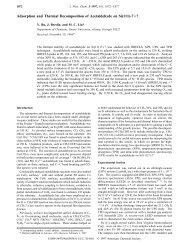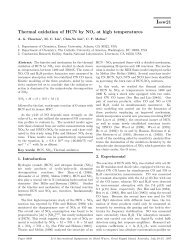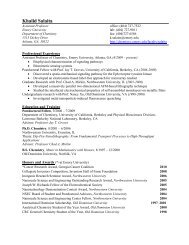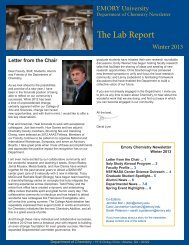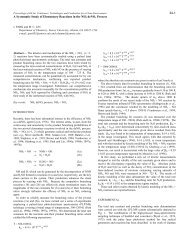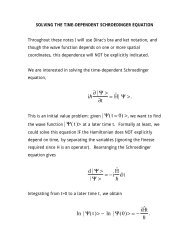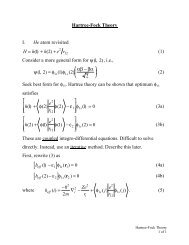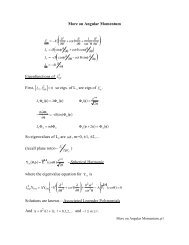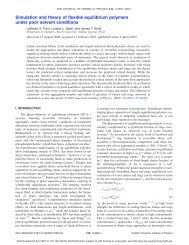Hydrogen Atom The Hamiltonian in spherical polar ... - Chemistry
Hydrogen Atom The Hamiltonian in spherical polar ... - Chemistry
Hydrogen Atom The Hamiltonian in spherical polar ... - Chemistry
Create successful ePaper yourself
Turn your PDF publications into a flip-book with our unique Google optimized e-Paper software.
<strong>Hydrogen</strong> <strong>Atom</strong><br />
<strong>The</strong> <strong>Hamiltonian</strong> <strong>in</strong> <strong>spherical</strong> <strong>polar</strong> coord<strong>in</strong>ates is<br />
H = − h2<br />
2µ ( ∂2<br />
∂r 2 + 2 r<br />
∂<br />
∂r ) + l 2<br />
op<br />
2µr 2 − Ze 2<br />
r<br />
where is the square of angular momentum operator l 2 op . Note that the<br />
2<br />
potential depends only on r and so H commutes with l op and l z . Thus<br />
eigenfunctions of H can be written <strong>in</strong> the form R n,l (r)Y l,m (θ,φ ), where<br />
R n,l (r) satisfies<br />
[− h2<br />
2µ ( ∂2<br />
∂r 2 + 2 ∂ l(l +1)h2<br />
) +<br />
r ∂r 2µr 2 − Ze 2<br />
− En ]R<br />
r nl (r)= 0<br />
To proceed, exam<strong>in</strong>e the solution for r large, and also need to exam<strong>in</strong>e<br />
behavior as r goes to zero, because of the s<strong>in</strong>gular nature of Coulomb<br />
potential. It is sometimes convenient to <strong>in</strong>troduce a new function<br />
u n,l (r)=rR n,l (r) <strong>in</strong> terms of which the above equation is<br />
[− h2<br />
2µ<br />
d 2 l(l +1)h2<br />
2 +<br />
2µr 2 − Ze 2<br />
− En ]u<br />
r nl (r)= 0<br />
dr<br />
(Prove this for homework).<br />
Re-write as<br />
[ d2 l(l +1)<br />
2 −<br />
dr 2r 2 + 2µZe 2 2µE<br />
rh 2 + n<br />
h 2 ]u nl (r)=0
as usual, get the asymptotic solution. <strong>The</strong> differential equation is then<br />
[ d2<br />
dr 2 + 2µE n<br />
h 2 ]u nl (r)=0<br />
and recall that E n is negative. So the asymptotic solution is of the form<br />
u nl (r)~exp(−κr)<br />
κ =<br />
− 2µE n<br />
h 2 .<br />
Near the orig<strong>in</strong>, and for l > 0 the differential equation is<br />
[ d2 l(l +1)<br />
2 −<br />
dr 2r 2 ]u nl (r)=0.<br />
<strong>The</strong> general solution is u nl (r)= Ar l+1 + Br −l , but B must equal zero for an<br />
acceptable solution. Thus, the general solution is of the form<br />
u nl (r)=r l+1 e −κr v(r)<br />
Introduce a new variable as follows ρ =κr, and then let<br />
and the equation for v is<br />
u nl (r)= ρ l+1 e −ρ v nl (ρ)<br />
d 2 v +1 dv<br />
2 + 2(l<br />
dρ ρ 2 −1)<br />
dρ + [V E<br />
2(l +1)<br />
− ]v = 0<br />
ρ<br />
where V is the Coulomb potential. Develop a series for v and exam<strong>in</strong>e the<br />
asymptotic form, and see that the series diverges as e 2ρ unless it term<strong>in</strong>ates
at some power N. Do<strong>in</strong>g that gives the result that Ze2 κ<br />
E<br />
= 2(N + l +1) and rearrang<strong>in</strong>g<br />
give<br />
E n = − Z 2 e 4 µ<br />
2h 2 2 ; n = (N + l +1).<br />
n<br />
Thus, as <strong>in</strong> the two-dimensional isotropic harmonic oscillator, there is a<br />
degeneracy <strong>in</strong> the eigenvalues, i.e., for each n l varies from 0 to n-1, and so<br />
there are n+1 values of l. In addtion, for each lthere are 2 l+1 values of m.<br />
Recall - l≤ m ≤ l. So, the total degeneracy is<br />
n −1<br />
g n<br />
= ∑ 2l +1 = 1+ 3 + 5 + ... + 2(n −1) +1 = n 2<br />
l = 0



